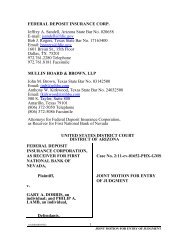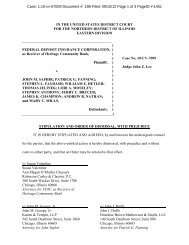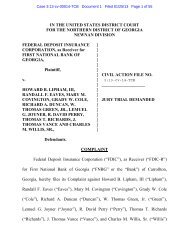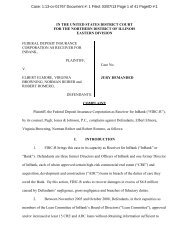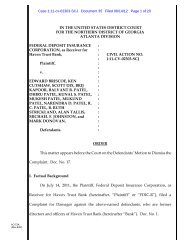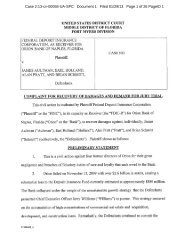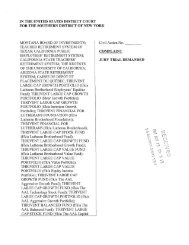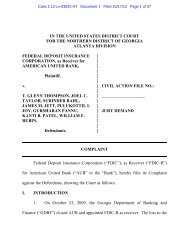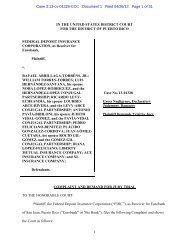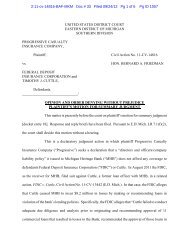Case 2:10-cv-04915-DSF-CW Document - OakBridge Insurance ...
Case 2:10-cv-04915-DSF-CW Document - OakBridge Insurance ...
Case 2:10-cv-04915-DSF-CW Document - OakBridge Insurance ...
You also want an ePaper? Increase the reach of your titles
YUMPU automatically turns print PDFs into web optimized ePapers that Google loves.
<strong>Case</strong> 2:<strong>10</strong>-<strong>cv</strong>-<strong>04915</strong>-<strong>DSF</strong>-<strong>CW</strong> <strong>Document</strong> 397 Filed <strong>10</strong>/05/12 Page 1 of 21 Page ID<br />
#:27215<br />
UNITED STATES DISTRICT COURT<br />
CENTRAL DISTRICT OF CALIFORNIA<br />
MEMORANDUM<br />
<strong>Case</strong> No. CV <strong>10</strong>-4915 <strong>DSF</strong> (SHx) Date <strong>10</strong>/5/12<br />
Title Federal Deposit <strong>Insurance</strong> Corp. v. Scott Van Dellen, et al.<br />
Present: The<br />
Honorable<br />
DALE S. FISCHER, United States District Judge<br />
Debra Plato Not Present<br />
Deputy Clerk Court Reporter<br />
Attorneys Present for Plaintiffs: Attorneys Present for Defendants:<br />
Not Present Not Present<br />
Proceedings: (In Chambers) Order GRANTING in Part and DENYING in Part<br />
Motions for Partial Summary Judgment (Docket Nos. 188, 189,<br />
193, 199, 216)<br />
I. FACTUAL AND PROCEDURAL BACKGROUND<br />
IndyMac Bank, F.S.B. (Bank), a wholly owned subsidiary of IndyMac Bankcorp,<br />
Inc. (Bankcorp) (Pl.’s Shellem and Koon SGD 1 16), was a federally insured and<br />
chartered bank with a home office in Pasadena, California. (Defs.’ SGD 2 1.) Bankcorp<br />
was incorporated in Delaware. (Pl.’s Shellem and Koon SGD 17.) The Bank<br />
originated mortgages in all 50 states. (Id. 18.)<br />
The Bank had a Homebuilder Division (HBD) that originated certain types of loans<br />
to homebuilders in selected markets throughout the United States. (Compl. 4; Shellem<br />
Ans. 4. 3 ) HBD provided land, acquisition, and development (A&D), construction and<br />
combined acquisition, development, and construction (AD&C) loans to homebuilders in<br />
selected markets throughout the United States. (Id.) HBD’s primary focus was on non-<br />
1 FDIC-R’s Statement of Genuine Disputes in Response to Defendants Shellem’s and Koon’s<br />
Statement of [Proposed] Uncontroverted Facts and Conclusions of Law. (Docket No. 243.)<br />
2 Defendants’ Statement of Genuine Disputes of Material Facts and Additional Material Facts<br />
in Support of Opposition to Plaintiff’s Motion for Partial Summary Judgment. (Docket No.<br />
229.)<br />
3 Docket No. 18.<br />
CV-90 (12/02) MEMORANDUM Page 1 of 21
<strong>Case</strong> 2:<strong>10</strong>-<strong>cv</strong>-<strong>04915</strong>-<strong>DSF</strong>-<strong>CW</strong> <strong>Document</strong> 397 Filed <strong>10</strong>/05/12 Page 2 of 21 Page ID<br />
#:27216<br />
UNITED STATES DISTRICT COURT<br />
CENTRAL DISTRICT OF CALIFORNIA<br />
MEMORANDUM<br />
public regional builders. (Id.) Kenneth Shellem was the Chief Credit Officer of HBD<br />
from early 2002 through some time between November 9 and 15, 2006. (Pl.’s Shellem<br />
and Koon SGD 1, 3.) Shellem remained a Bank employee until March 31, 2007. (Id.<br />
4.) Richard Koon was HBD’s Chief Lending Officer (CLO) from July 2001 until his<br />
retirement on July 15, 2006. (Id. 5.) Scott Van Dellen was president of HBD between<br />
mid-2002 and July 2008. (Compl. 13; Van Dellen Ans. 4 13.) William Rothman<br />
became HBD’s CLO in July 2006. (Compl. 16; Rothman Ans. 5 16.)<br />
The Office of Thrift Supervision (OTS) 6 closed the Bank on July 11, 2008. (Pl.’s<br />
Shellem and Koon SGD 19.) The Federal Deposit <strong>Insurance</strong> Corporation (FDIC) was<br />
appointed receiver of the Bank on July 17, 2008. (Id. 20.) On July 2, 20<strong>10</strong>, the FDIC,<br />
as receiver, brought suit pursuant to 12 U.S.C. § 1821(d)(2) against Van Dellen, Koon,<br />
Shellem, and Rothman as former officers of the Bank. The FDIC claims Defendants<br />
were negligent and breached their fiduciary duties in approving certain HBD loans.<br />
The loans at issue were approved between July 2005 and January 2007. (Pl.’s Van<br />
Dellen and Rothman SGD 7 4.) Two loan approval committees were involved. First, the<br />
HBD Management Loan Committee, also known as the Junior Loan Committee (JLC),<br />
had authority to approve loans below 30 million dollars in value. (Pl.’s Shellem and<br />
Koon SGD 7, 11.) Second, the HBD Executive Loan Committee, also known as the<br />
Senior Loan Committee (SLC), had to approve loans in excess of 30 million dollars after<br />
the JLC approved them for recommendation. (Id. 12.) In order to approve a loan<br />
within its authority or to recommend a loan to the SLC, the JLC vote had to be<br />
unanimous. (Id. 13.) If the majority of the JLC members were in favor of a loan within<br />
their approval authority but the vote was not unanimous, the loan would be submitted to<br />
the SLC. (Id. 14.) The SLC consisted of non-party Bank President Richard Wohl, nonparty<br />
Bank CEO Michael Perry, and Van Dellen. (Id. 14.) Koon was a voting member<br />
of the JLC. (Defs.’ SGD 6-7.) Van Dellen was a member of both the JLC and SLC.<br />
(Id. 5.) Shellem was a voting member of the JLC. (Id. 8-9.) Rothman was a voting<br />
4 Docket No. 33.<br />
5 Docket No. 34.<br />
6 As a federal savings bank, the Bank was regulated and chartered primarily by OTS and<br />
secondarily by the FDIC. See Jeffrey L. Hare & Christopher N. Steelman, When Private-<br />
Equity Meets Banks: The Impact of Banking Regulations on Private-Equity Investment, 125<br />
Banking L.J. 487 (2008).<br />
7 FDIC-R’s Statement of Genuine Disputes in Response to Defendants Van Dellen’s and<br />
Rothman’s Statement of Uncontroverted Facts and Conclusions of Law.<br />
CV-90 (12/02) MEMORANDUM Page 2 of 21
<strong>Case</strong> 2:<strong>10</strong>-<strong>cv</strong>-<strong>04915</strong>-<strong>DSF</strong>-<strong>CW</strong> <strong>Document</strong> 397 Filed <strong>10</strong>/05/12 Page 3 of 21 Page ID<br />
#:27217<br />
UNITED STATES DISTRICT COURT<br />
CENTRAL DISTRICT OF CALIFORNIA<br />
MEMORANDUM<br />
member of the JLC after July 2006. (Id. 11.)<br />
On August 22, 2012, the FDIC moved for partial summary judgment as to certain<br />
of Defendants’ affirmative defenses. (Docket No. 188.) Shellem moves separately for<br />
summary judgment. (Docket No. 189.) Van Dellen and Rothman move for partial<br />
summary judgment and join in the partial summary judgment motion of Koon and<br />
Shellem. (Docket No. 193.) Koon and Shellem move for partial summary judgment and<br />
join in the partial summary judgment motion of Van Dellen and Rothman. (Docket No.<br />
199, 216.)<br />
II. LEGAL STANDARD<br />
The standard and procedures for a motion for partial summary judgment are the<br />
same as for summary judgment of a claim. Delta Sav. Bank v. United States, 265 F.3d<br />
<strong>10</strong>17, <strong>10</strong>21 (9th Cir. 2001); Fed. R. Civ. P. 56(a). A movant is entitled to summary<br />
judgment on a showing that there is no genuine dispute as to any material fact and the<br />
movant is entitled to judgment as a matter of law. The moving party need not disprove<br />
the opposing party’s case. Celotex Corp. v. Catrett, 477 U.S. 317, 323 (1986). Rather, if<br />
the moving party satisfies this burden, the party opposing the motion must set forth<br />
specific facts, through affidavits or admissible discovery materials, showing that there<br />
exists a genuine issue for trial. Id. at 323-24; Fed. R. Civ. P. 56(c)(1). “This burden is<br />
not a light one.” In re Oracle Corp. Sec. Litig., 627 F.3d 376, 387 (9th Cir. 20<strong>10</strong>). If the<br />
moving party’s showing is insufficient, no defense is required. Harper v. Wallingford,<br />
877 F.2d 728, 731 (9th Cir. 1989). In ruling on a summary judgment motion, the Court<br />
must construe the evidence in the light most favorable to the non-moving party. Nolan v.<br />
Heald College, 551 F.3d 1148, 1154 (9th Cir. 2009).<br />
A non-moving party who bears the burden of proof at trial as to an element<br />
essential to its case must make a showing sufficient to establish a genuine dispute of fact<br />
with respect to the existence of that element of the case or be subject to summary<br />
judgment. See Celotex Corp., 477 U.S. at 322. If the moving party’s showing is<br />
insufficient, no defense is required. Harper v. Wallingford, 877 F.2d 728, 731 (9th Cir.<br />
1989). “[A] district court is not entitled to weigh the evidence and resolve disputed<br />
underlying factual issues.” Chevron Corp. v. Pennzoil Co., 974 F.2d 1156, 1161 (9th Cir.<br />
1992). Rather, “the inferences to be drawn from the underlying facts must be viewed in<br />
the light most favorable to the party opposing the motion.” Matsushita Elec. Indus. Co.<br />
v. Zenith Radio Corp., 475 U.S. 574, 587-88 (internal quotation marks and ellipsis<br />
omitted).<br />
III. DISCUSSION<br />
CV-90 (12/02) MEMORANDUM Page 3 of 21
<strong>Case</strong> 2:<strong>10</strong>-<strong>cv</strong>-<strong>04915</strong>-<strong>DSF</strong>-<strong>CW</strong> <strong>Document</strong> 397 Filed <strong>10</strong>/05/12 Page 4 of 21 Page ID<br />
#:27218<br />
UNITED STATES DISTRICT COURT<br />
CENTRAL DISTRICT OF CALIFORNIA<br />
A. Choice of Law<br />
MEMORANDUM<br />
Plaintiff contends California law applies here; Defendants argue for Delaware law.<br />
The Ninth Circuit has not directly addressed the choice of law issue under the Financial<br />
Institutions Reform, Recovery and Enforcement Act of 1989 (FIRREA), which provides<br />
this Court with jurisdiction over this action. It has, however, determined that federal<br />
common law applies in an analogous context. Huynh v. Chase Manhattan Bank, 465<br />
F.3d 992 (2006). The particular choice of law mechanism is irrelevant here because<br />
California law governs under each test – the “internal affairs doctrine,” the Lidow v.<br />
Super. Ct., 206 Cal. App. 4th 351 (2012) choice of law test, and federal common law.<br />
1. Internal Affairs Doctrine<br />
California courts generally follow the internal affairs doctrine. Vaughn v. LJ Int’l,<br />
Inc., 174 Cal. App. 4th 213, 223 (2009). The doctrine is “a conflict of laws principle<br />
which recognizes that only one State should have the authority to regulate a corporation’s<br />
internal affairs.” Edgar v. MITE Corp., 457 U.S. 624, 645 (1982). Generally, the<br />
internal affairs of a corporation involve “relations inter se of the corporation, its<br />
shareholders, directors, officers or agents.” Restatement (Second) Conflicts of Law §<br />
302(1) cmt. a (1971). In determining the applicable state law under the doctrine, the<br />
Court is informed by the Supreme Court’s decision in Atherton v. FDIC, 519 U.S. 213<br />
(1997). Atherton tacitly approved the application of the internal affairs doctrine in suits<br />
by the FDIC as receiver for a federally chartered bank against former officers and<br />
directors for negligence and breach of fiduciary duty. Id. at 223-24. The Supreme Court<br />
suggested:<br />
In the absence of a governing federal common law, courts applying the internal<br />
affairs doctrine could find (we do not say what they will find) that the State<br />
closest analogically to the State of incorporation of an ordinary business is the<br />
State in which the federally chartered bank has its main office or maintains its<br />
principal place of business.<br />
Atherton, 519 U.S. at 224 (citations omitted).<br />
Defendants argue at length about Bankcorp’s incorporation in Delaware, its<br />
conducting business substantially through the Bank, and its structural arrangement of<br />
having joint directors of Bankcorp and the Bank. (Defs.’ SGD 99-<strong>10</strong>3.) 8<br />
8 Plaintiff objects to two documents that form the basis for Defendants’ claims about the joint<br />
directors and corporate structure of the Bank and Bankcorp, (Docket No. 265 at 1): “IndyMac<br />
CV-90 (12/02) MEMORANDUM Page 4 of 21
<strong>Case</strong> 2:<strong>10</strong>-<strong>cv</strong>-<strong>04915</strong>-<strong>DSF</strong>-<strong>CW</strong> <strong>Document</strong> 397 Filed <strong>10</strong>/05/12 Page 5 of 21 Page ID<br />
#:27219<br />
UNITED STATES DISTRICT COURT<br />
CENTRAL DISTRICT OF CALIFORNIA<br />
MEMORANDUM<br />
The FDIC argues that California law should apply because California is the state<br />
“closest analogically to the State of incorporation.” The Bank selected California for its<br />
main office and principal place of business 9 , (Defs.’ SGD 1), wrote its Bylaws to place<br />
all emergency alternative home offices in California, and required that all annual and<br />
special shareholder meetings take place at the Bank’s home office in California, (id. 3-<br />
4). Moreover, even with respect to documents directly at issue in this litigation, the Bank<br />
chose to avail itself of California law. In Shellem’s severance agreement, the Bank<br />
selected California law to govern the “rights and obligations” of the parties. (Shellem’s<br />
UF 27; Docket No. 192.) The mere incorporation status of Bankcorp does not override<br />
the Bank’s repeated governance choices to be subject to, and take advantage of,<br />
California law.<br />
Defendants cite no precedent indicating that the state of incorporation of a parent<br />
should dictate the choice of law analysis for a federally chartered bank <strong>10</strong> , but they assert a<br />
regulation adopted by OTS, the Bank’s primary regulator, bolsters their claim that<br />
Delaware law governs. The regulation states:<br />
Corporate governance procedures. A Federal stock association may elect to<br />
follow the corporate governance procedures of: The laws of the state where the<br />
main office of the association is located; the laws of the state where the<br />
Bancorp Organizational Chart” and “Meeting of the Boards of Directors Meeting Handout”<br />
offered as part of the Declaration of Igor V. Timofeyev. The objections are SUSTAINED as<br />
these documents have not been properly authenticated and defense counsel has not established<br />
personal knowledge sufficient to authenticate the exhibits. The Court’s ruling would be the<br />
same even if these documents were considered.<br />
9 Defendants attempt to dispute that the Bank had a “main office and principal place of<br />
business in Pasadena, California,” arguing “Plaintiff’s evidence demonstrates only that<br />
IndyMac’s home office was in Pasadena, California, but does not indicate its ‘main’ office or<br />
‘principal place of business.’” (Defs.’ SGD 1.) This is a distinction without a difference and<br />
falls well short of raising a genuine dispute of material fact. Defendants have failed to provide<br />
any evidence indicating a different home office or principal place of business.<br />
<strong>10</strong> Defendants point to a District of Connecticut decision, which involved a breach of contract<br />
action brought by the Bank against two individuals. The district court, in a footnote and<br />
without conflict of law or any corporate governance analysis, identified IndyMac as “a<br />
Delaware corporation with its principal place of business in California.” IndyMac Bank,<br />
F.S.B. v. Reyad, Civil Action No. 3:00CV835(CFD), 2006 WL 2092621, at *1 n.1 (D. Conn.<br />
July 26, 2006). This decision is not on point and there is no argument here that the Bank is a<br />
corporation at all.<br />
CV-90 (12/02) MEMORANDUM Page 5 of 21
<strong>Case</strong> 2:<strong>10</strong>-<strong>cv</strong>-<strong>04915</strong>-<strong>DSF</strong>-<strong>CW</strong> <strong>Document</strong> 397 Filed <strong>10</strong>/05/12 Page 6 of 21 Page ID<br />
#:27220<br />
UNITED STATES DISTRICT COURT<br />
CENTRAL DISTRICT OF CALIFORNIA<br />
MEMORANDUM<br />
association’s holding company, if any, is incorporated or chartered; Delaware<br />
General Corporation law; or The Model Business Corporation Act, provided<br />
that such procedures may be elected to the extent not inconsistent with<br />
applicable Federal statutes and regulations and safety and soundness, and such<br />
procedures are not of the type described in paragraph (b)(1) of this section. If<br />
this election is selected, a Federal stock association shall designate in its bylaws<br />
the provision or provisions from the body or bodies of law selected for its<br />
corporate governance procedures, and shall file a copy of such bylaws, which<br />
are effective upon adoption, within 30 days after adoption.<br />
12 C.F.R. § 552.5(b)(3). A final rule enacting this new corporate governance option was<br />
issued on December 3, 1996, long before the 2008 closing of the Bank and the FDIC’s<br />
receivership. Corporate Governance, 61 Fed. Reg. 64,007, 64,019 (Dec. 3, 1996) (to be<br />
codified at 12 C.F.R. § 552.5). At any time in the twelve years between December 1996<br />
and July 2008, the Bank could have made clear it was subject to Delaware corporate<br />
governance law by complying with the provisions of this regulation, but did not do so. 11<br />
The Court finds that California law applies under an internal affairs analysis.<br />
2. Action Outside the Scope of the Internal Affairs Doctrine<br />
Even if the internal affairs doctrine does not apply, California law applies<br />
under Lidow v. Super. Ct. Lidow considered the proper substantive law to apply to a<br />
Delaware corporation based in California for a claim brought by an officer for wrongful<br />
termination in violation of California’s public policy. 206 Cal. App. 4th at 354. Lidow<br />
held that “a claim for wrongful termination of public policy brought by an officer of a<br />
foreign corporation falls outside the scope of the internal affairs doctrine, and thus is<br />
governed by California law.” Id. at 356-57. The court applied “a vital limitation to the<br />
internal affairs doctrine” and explained that the internal affairs doctrine will be applied<br />
“except where, with respect to the particular issue, some other state has a more significant<br />
relationship [under the principles stated in § 6] 12 to the parties and the transaction.” Id. at<br />
11 Defendants’ claim that “IndyMac’s Board relied on section 141(c) of the Delaware General<br />
Corporation Law, 8 Del. C. § 141(c), when appointing several IndyMac directors as members<br />
of IndyMac’s Enterprise Risk Management Committee,” and other similar claims (Defs.<br />
Shellem and Koon’s Opp. 9-<strong>10</strong>), do not change this Court’s analysis. These scattered<br />
corporate governance actions are heavily outweighed by the factors noted above.<br />
12 Section 6 of the Restatement does not compel a different conclusion as to the governing law.<br />
As explained below, section 6 mandates the conclusion that California law applies.<br />
CV-90 (12/02) MEMORANDUM Page 6 of 21
<strong>Case</strong> 2:<strong>10</strong>-<strong>cv</strong>-<strong>04915</strong>-<strong>DSF</strong>-<strong>CW</strong> <strong>Document</strong> 397 Filed <strong>10</strong>/05/12 Page 7 of 21 Page ID<br />
#:27221<br />
UNITED STATES DISTRICT COURT<br />
CENTRAL DISTRICT OF CALIFORNIA<br />
MEMORANDUM<br />
359 (citing Restatement (Second) Conflicts of Law § 309 (1971)). “[C]ourts are less apt<br />
to apply the internal affairs doctrine when vital statewide interests are at stake, such as<br />
maintaining the integrity of California security markets and protecting its citizens from<br />
harmful conduct.” Id. at 362. California has a significant interest in regulating the<br />
conduct and setting the standard of care for corporate officers where the corporation’s<br />
main offices and principal places of businesses are located in California and the<br />
corporation chooses California law in its contractual choice of law provisions. This is in<br />
contrast to Delaware’s more distant interest and the scattered occurrences where the Bank<br />
and Bankcorp purported to look to Delaware law in governance decisions. Even if the<br />
duty of care owed by corporate officers falls outside the scope of the internal affairs test,<br />
California law is applicable under Lidow.<br />
3. Federal Common Law<br />
Even under a federal common law choice of law analysis, California law governs.<br />
The Ninth Circuit addressed an analogous choice of law issue Huynh v. Chase Manhattan<br />
Bank. Huynh was an Edge Act case removed “to federal court pursuant to 12 U.S.C. §<br />
632, which invests in the federal courts original jurisdiction over cases arising out of<br />
foreign banking transactions to which a U.S. corporation is a party.” 465 F.3d at 997. In<br />
considering the proper state statute of limitations to apply, the Ninth Circuit concluded:<br />
[J]urisdiction is not based on diversity of citizenship. In this context, federal<br />
common law choice-of-law rules apply. Federal common law follows the<br />
approach outlined in the Restatement (Second) of Conflicts of Laws<br />
[Restatement Factors for statute of limitations determinations] . . . . The<br />
formulation of this rule is intended to reflect the general choice-of-law<br />
principles stated in Restatement (Second) Conflicts of Law § 6.<br />
Id. (citations omitted); see also Edelmann v. Chase Manhattan Bank, N.A., 861 F.2d<br />
1291, 1294 (1st Cir. 1988) (applying federal common law choice of law provisions to an<br />
Edge Act case); but see A.I. Trade Fin., Inc. v. Petra Int’l Banking Corp., 62 F.3d 1454,<br />
1463 (D.C. Cir. 1995) (applying state choice-of-law rules to an Edge Act suit where “the<br />
‘federal question’ giving rise to federal jurisdiction need not appear upon the face of a<br />
well-pleaded complaint”). The specific Restatement choice of law principles for<br />
corporate powers and liabilities applicable here are provided in sections 302 and 309.<br />
Section 302 deals “with issues involving matters that are peculiar to corporations . .<br />
. . Many of the matters that fall within the scope of the rule of this Section involve the<br />
‘internal affairs’ of a corporation.” Restatement (Second) Conflicts of Law, cmt. a.<br />
Section 302 reads:<br />
CV-90 (12/02) MEMORANDUM Page 7 of 21
<strong>Case</strong> 2:<strong>10</strong>-<strong>cv</strong>-<strong>04915</strong>-<strong>DSF</strong>-<strong>CW</strong> <strong>Document</strong> 397 Filed <strong>10</strong>/05/12 Page 8 of 21 Page ID<br />
#:27222<br />
UNITED STATES DISTRICT COURT<br />
CENTRAL DISTRICT OF CALIFORNIA<br />
MEMORANDUM<br />
(1) Issues involving the rights and liabilities of a corporation, other than those<br />
dealt with in § 301, are determined by the local law of the state which, with<br />
respect to the particular issue, has the most significant relationship to the<br />
occurrence and the parties under the principles stated in § 6.<br />
(2) The local law of the state of incorporation will be applied to determine such<br />
issues, except in the unusual case where, with respect to the particular issue,<br />
some other state has a more significant relationship to the occurrence and the<br />
parties, in which event the local law of the other state will be applied.<br />
For the reasons discussed in the Lidow analysis above, the Court finds California has the<br />
most significant relationship to the particular issue and the parties (all Defendants are<br />
residents of California) under section 302(1) and that Delaware does not have a more<br />
significant relationship to the occurrences and the parties under section 302(2).<br />
Section 309 covers the choice of law used in “determin[ing] the liability of a[n] . . .<br />
officer to the corporation.” Restatement (Second) Conflicts of Law, cmt. a. For the<br />
reasons discussed in the Lidow analysis above, which directly incorporated this section<br />
into its choice of law analysis, the Court finds that California law applies.<br />
Finally, California law applies even under the general choice of law principles in<br />
section 6 of the Restatement. Section 6 states:<br />
(1) A court, subject to constitutional restrictions, will follow a statutory<br />
directive of its own state on choice of law.<br />
(2) When there is no such directive, the factors relevant to the choice of the<br />
applicable rule of law include<br />
(a) the needs of the interstate and international systems,<br />
(b) the relevant policies of the forum,<br />
(c) the relevant policies of other interested states and the relative<br />
interests of those states in the determination of the particular issue,<br />
(d) the protection of justified expectations,<br />
(e) the basic policies underlying the particular field of law,<br />
(f) certainty, predictability and uniformity of result, and<br />
(g) ease in the determination and application of the law to be applied<br />
In addition to the reasons explained in the Atherton and Lidow analyses above that<br />
directly address factors (2)(a)-(c) and (e), the Court finds that factors 2(d) and (f) weigh<br />
in favor of applying California law as, for example, the Bank chose California law to<br />
CV-90 (12/02) MEMORANDUM Page 8 of 21
<strong>Case</strong> 2:<strong>10</strong>-<strong>cv</strong>-<strong>04915</strong>-<strong>DSF</strong>-<strong>CW</strong> <strong>Document</strong> 397 Filed <strong>10</strong>/05/12 Page 9 of 21 Page ID<br />
#:27223<br />
UNITED STATES DISTRICT COURT<br />
CENTRAL DISTRICT OF CALIFORNIA<br />
MEMORANDUM<br />
control Shellem’s severance agreement. The Court finds that the federal common law<br />
choice of law test favors the application of substantive California law.<br />
B. Business Judgment Rule<br />
1. Present State of California Law<br />
As California substantive law applies, California’s business judgment rule applies.<br />
The rule “has two components– immunization from liability that is codified at<br />
Corporations Code Section 309 and a judicial policy of deference to the exercise of goodfaith<br />
business judgment in management decisions.” Berg & Berg Enters., LLC v. Boyle,<br />
178 Cal. App. 4th <strong>10</strong>20, <strong>10</strong>48 (2009). It “requires directors to perform their duties in<br />
good faith and as an ordinarily prudent person in a like circumstance would.” FDIC v.<br />
Castetter, 184 F.3d <strong>10</strong>40, <strong>10</strong>44 (9th Cir. 1999). The first component, “which immunizes<br />
directors from personal liability if they act in accordance with its requirements,” is<br />
codified at Section 309. Berg, 178 Cal. App. 4th at <strong>10</strong>45. Defendants concede section<br />
309 does not apply to them. The only question then is whether the common law element<br />
of the business judgment rule applies.<br />
That element has been described as “insulat[ing] from court intervention those<br />
management decisions which are made by directors in good faith in what the directors<br />
believe is the organization’s best interest.” Id. (emphasis added) (citing Lee v.<br />
Interinsurance Exch. of the Auto. Club of S. Cal., 50 Cal. App. 4th 694, 714 (1996);<br />
Lamden v. La Jolla Shores Clubdominium Homeowners Ass’n, 21 Cal. 4th 249, 257<br />
(1999)); see also Barnes v. State Farm Mut. Auto. Ins. Co., 16 Cal. App. 4th 365, 378<br />
(1993) (describing “a judicial policy of deference to the business judgment of corporate<br />
directors in the exercise of their broad discretion in making corporate decisions”).<br />
Defendants argue that the Court should extend the California common law business<br />
judgment rule by finding that officers, in addition to directors and officer-directors, are<br />
CV-90 (12/02) MEMORANDUM Page 9 of 21
<strong>Case</strong> 2:<strong>10</strong>-<strong>cv</strong>-<strong>04915</strong>-<strong>DSF</strong>-<strong>CW</strong> <strong>Document</strong> 397 Filed <strong>10</strong>/05/12 Page <strong>10</strong> of 21 Page ID<br />
#:27224<br />
UNITED STATES DISTRICT COURT<br />
CENTRAL DISTRICT OF CALIFORNIA<br />
MEMORANDUM<br />
entitled to its protections. California courts have not extended the rule to officers 13 , and<br />
this Court declines to do so.<br />
2. Biren<br />
The case on which Defendants primarily rely is easily distinguishable. 14 In Biren<br />
v. Equal. Emergency Med. Grp., Inc., <strong>10</strong>2 Cal. App. 4th 125, 132 (2002), the court of<br />
appeal held that the business judgment rule “may protect a director who acts in a<br />
mistaken but good faith belief on behalf of the corporation without obtaining required<br />
shareholder approval.” Biren involved two corporations created to provide emergency<br />
room services to hospitals under contract. Each corporation had five physician owners,<br />
each of whom was a corporate officer, director, and twenty percent shareholder. A<br />
written agreement among them required the consent of a majority of the shareholders for<br />
such things as contracting for billing services. Biren terminated the corporation’s billing<br />
company and contracted with another company without the required consent and failed to<br />
13 The most straightforward discussion of the scope of the business judgment rule is found in<br />
Gaillard v. Natomas Co., 208 Cal. App. 3d 1250 (1989). While it is unclear whether Gaillard<br />
concluded section 309 had codified the entire business judgment rule or merely part of it, the<br />
court discussed its view of the scope of and rationale behind the rule:<br />
The judicial deference afforded under the business judgment rule therefore should<br />
not apply [to individuals not “perform[ing] the duties of a director”]. As stated by<br />
Marsh in his discussion of section 309: “[Section 309, subdivision (a)] does not<br />
relate to officers of the corporation, but only to directors. . . . [A]n officer-director<br />
might be liable for particular conduct because of his capacity of an officer, whereas<br />
the other directors would not. . . . This result is in accord with the premise of the<br />
business judgment rule that courts should defer to the business judgment of<br />
disinterested directors who presumably are acting in the best interests of the<br />
corporation.<br />
Id. at 1265-66 (initial brackets added; internal citation omitted). While Gaillard is not<br />
dispositive on the instant issue, it provides insight into how California courts view the business<br />
judgment rule.<br />
14 Defendants also cite without explanation PMC, Inc. v. Kadisha, 78 Cal. App. 4th 1368<br />
(2000). Their reliance on this case is misplaced. Kadisha addressed an officer’s or director’s<br />
liability for a tort against a third party. The portion of the decision discussing the business<br />
judgment rule referred only to directors. Id. at 1386-87.<br />
CV-90 (12/02) MEMORANDUM Page <strong>10</strong> of 21
<strong>Case</strong> 2:<strong>10</strong>-<strong>cv</strong>-<strong>04915</strong>-<strong>DSF</strong>-<strong>CW</strong> <strong>Document</strong> 397 Filed <strong>10</strong>/05/12 Page 11 of 21 Page ID<br />
#:27225<br />
UNITED STATES DISTRICT COURT<br />
CENTRAL DISTRICT OF CALIFORNIA<br />
MEMORANDUM<br />
make certain pension contributions. The other shareholders contended she was liable for<br />
breach of contract, breach of fiduciary duty, and negligence.<br />
Defendants seize on the appellate court’s reference to the fact that Biren herself<br />
had a “mistaken belief that as an officer and director she had authority to act” on behalf<br />
of the corporation, and her own explanation that she had a fiduciary responsibility “as<br />
CFO,” to argue that the court determined that the business judgment rule protects<br />
officers. 15 Not so. The court did not adopt Biren’s apparent view that she was protected<br />
as an officer as well as a director. Indeed, Biren’s analysis begins with a quote from the<br />
Ninth Circuit’s Castetter decision: “[T]he [business judgment] rule . . . protect[s] wellmeaning<br />
directors who are misinformed, misguided, and honestly mistaken.” <strong>10</strong>2 Cal.<br />
App. 4th at 137 (quoting Castetter, 184 F.3d at <strong>10</strong>46). All of the precedent cited by the<br />
court mentions only directors, never officers, in discussing the business judgment rule.<br />
Id. at 137 (citing Barnes, 16 Cal. App. 4th at 378, Lee, 50 Cal. App. 4th at 715, Castetter,<br />
184 F.3d at <strong>10</strong>46, and FDIC v. Benson, 867 F. Supp. 512, 522 (S.D. Tex. 1994)).<br />
Had the court in Biren intended to extend the California common law business<br />
judgment rule to protect officers, it would have said so more forthrightly. Biren does not<br />
change California law as to the scope of the business judgment rule.<br />
3. The California Law Revision Commission<br />
The California Law Revision Commission also views the common law and<br />
statutory portions of the business judgment rule as extending only to directors. To<br />
accomplish its mission of substantive review of California statutory and decisional law,<br />
the Commission: (1) holds meetings, (2) conducts background studies, (3) prepares staff<br />
memoranda, (4) issues tentative recommendations, and (5) issues a final recommendation<br />
to the legislature. Commission Procedure, http://www.clrc.ca.gov/Mbg-history.html (last<br />
visited Sept. 19, 2012). In an early 1996 tentative recommendation, the Commission, in<br />
recommending the business judgment rule be applied to officers by statute, recognized<br />
that “[a]pplication of the business judgment rule to officers overrules the statement in<br />
Gaillard [], that the judicial deference afforded under the business judgment rule should<br />
15 Defendants’ arguments also take other portions of Biren’s analysis out of context. Biren<br />
cites a treatise explaining that “[t]he practice of allowing officers to approve contracts is so<br />
prevalent in some close corporations, for example, that they bind the entity even though the<br />
officer should have obtained board approval.” Id. at 137 (citing 2 Fletcher, Cyclopedia of the<br />
Law of Private Corporations § 394.<strong>10</strong>, at 246-47 (1998)). The treatise is relevant only as to the<br />
corporation’s closely held nature and informal governance structure; its citation does not<br />
indicate the court concluded plaintiff deserved protection for her status as an officer.<br />
CV-90 (12/02) MEMORANDUM Page 11 of 21
<strong>Case</strong> 2:<strong>10</strong>-<strong>cv</strong>-<strong>04915</strong>-<strong>DSF</strong>-<strong>CW</strong> <strong>Document</strong> 397 Filed <strong>10</strong>/05/12 Page 12 of 21 Page ID<br />
#:27226<br />
UNITED STATES DISTRICT COURT<br />
CENTRAL DISTRICT OF CALIFORNIA<br />
MEMORANDUM<br />
not apply to officers.” 16 Tentative Recommendation, #B-601, Business Judgment Rule<br />
Study B-601, (April 1996), http://www.clrc.ca.gov/pub/1996/M96-24.pdf, at 12.<br />
In its final recommendation to the California Legislature in 1998, the Commission<br />
ultimately did not suggest overruling Gaillard. The Commission made this decision clear<br />
in a heading titled “Codification Inapplicable to Officers.” Business Judgment Rule, 28<br />
Cal. L. Revision Comm’n Reports 1 (1998),<br />
http://clrc.ca.gov/pub/Printed-Reports/Pub197.pdf, at 17. The Commission concluded<br />
“that the codification of the business judgment rule should be limited to directors, and<br />
that its possible application to officers be made the subject of a separate study.<br />
Codification of the business judgment rule for directors should not affect the common<br />
law and existing statutory protection of officers and employees.” Id. at 17-18. The<br />
Commission explicitly recognized the lack of California decisional law including officers<br />
within the scope of the business judgment rule – and chose not to recommend extending<br />
its protections. The Court is left with only one reasonable conclusion 17 as to California<br />
substantive law — the state’s business judgment rule does not protect officers.<br />
Defendants may not use the business judgment rule as an affirmative defense. Plaintiff’s<br />
motion for summary judgment on this issue is GRANTED. Defendants’ motion for<br />
summary judgment as to all counts on the basis of the protections of the business<br />
judgment rule is DENIED.<br />
C. Reliance on Employees/Experts, Reasonable Grounds, Reliance on<br />
Experts and Good Faith<br />
Defendants do not appear to argue that these affirmative defenses are distinct from<br />
the business judgment rule. For the reasons stated above, Plaintiff’s motion is<br />
GRANTED.<br />
16 Defendants once again offer a quotation entirely out of context. They claim the Commission<br />
“endorsed” the view that “[t]he business judgment rule does apply to officers.” This quotation<br />
is from an early tentative draft and was never forwarded to the California legislature. It is<br />
immediately preceded by the Commission’s recognition that California decisional law was to<br />
the contrary and that “[a]pplication of the business judgment rule to officers overrules the<br />
statement in Gaillard.” Tentative Recommendation, #B-601, at 12.<br />
17 Where the California Supreme Court has not decided a state law “question or one analogous<br />
to it, [the Court] must ‘predict how the highest state court would decide the issue,’ using any<br />
relevant material as guidance.” Jerry Beeman & Pharmacy Servs., Inc. v. Anthem Prescription<br />
Mgmt., LLC, 652 F.3d <strong>10</strong>85, 1<strong>10</strong>6 (9th Cir. 2011) (quoting Vestar Dev. II, LLC v. Gen.<br />
Dynamics Corp, 249 F.3d 958, 960 (9th Cir. 2001)).<br />
CV-90 (12/02) MEMORANDUM Page 12 of 21
<strong>Case</strong> 2:<strong>10</strong>-<strong>cv</strong>-<strong>04915</strong>-<strong>DSF</strong>-<strong>CW</strong> <strong>Document</strong> 397 Filed <strong>10</strong>/05/12 Page 13 of 21 Page ID<br />
#:27227<br />
UNITED STATES DISTRICT COURT<br />
CENTRAL DISTRICT OF CALIFORNIA<br />
D. Statute of Limitations<br />
MEMORANDUM<br />
The FDIC alleges both breach of fiduciary duty and negligence. (Compl. 7.)<br />
Defendants concede that to determine the statute of limitations under California law, the<br />
Court must identify the nature, i.e. the gravamen, of the cause of action. (Defs. Shellem<br />
and Koon’s Opp. at 24; Van Dellen 7-8.) Plaintiff contends a four-year limitations period<br />
applies under California law because the gravamen of its claims is breach of fiduciary<br />
duty. Defendants argue for a two-year statute of limitations, asserting the gravamen of<br />
the claims is professional negligence.<br />
“Under [FIRREA], the FDIC has at least three years after a failed thrift goes into<br />
receivership to file tort claims against former officers or directors; any longer period<br />
under state law controls.” FDIC v. McSweeney, 976 F.2d 532, 534 (9th Cir. 1992). The<br />
parties agree 18 that the FDIC may not “revive claims for which the state limitations period<br />
has expired before the date of federal receivership.” Id. at 534. However, this is not an<br />
issue as the Court concludes that the relevant statute of limitations is four years under<br />
California law and thus none of the claims expired before the date of federal receivership.<br />
The Ninth Circuit’s decision in McSweeney is binding and conclusively resolves<br />
the dispute. The gravamen of the complaint here is breach of fiduciary duty, not<br />
professional or other negligence. 976 F.2d at 535-36. See also 1st Valley Credit Union<br />
v. Bland, No. CV <strong>10</strong>-1597-GW (MANx), 20<strong>10</strong> WL 8757250, at *<strong>10</strong> (C.D. Cal. Dec. 20,<br />
20<strong>10</strong>) (“Although the [federal credit union] Director Defendants first argue that a twoyear<br />
statute of limitations should apply to a fiduciary breach claim, they admit that such<br />
an argument is foreclosed by controlling Ninth Circuit authority, which sets the statute of<br />
limitations as four years”). There have been no intervening California court or Ninth<br />
Circuit decisions to the contrary.<br />
Because the applicable statute of limitations is four years, the FDIC may bring<br />
claims that accrued on or after July 17, 2004, which is four years before the FDIC was<br />
appointed as receiver. As there is no dispute that all claims accrued after that date,<br />
Defendants’ statute of limitations defense fails as a matter of law. Plaintiff’s summary<br />
judgment motion on this affirmative defense is GRANTED.<br />
E. Laches<br />
Defendants do not oppose Plaintiff’s motion on the affirmative defense of laches.<br />
In any event, “[u]nder California law, laches is available as a defense only to claims<br />
18 Pl.’s Mot. for Partial Summary Judgment at 12; Defs.’ Van Dellen and Rothman Opposition<br />
to Pl.’s Mot. for Partial Summary Judgment at 6.<br />
CV-90 (12/02) MEMORANDUM Page 13 of 21
<strong>Case</strong> 2:<strong>10</strong>-<strong>cv</strong>-<strong>04915</strong>-<strong>DSF</strong>-<strong>CW</strong> <strong>Document</strong> 397 Filed <strong>10</strong>/05/12 Page 14 of 21 Page ID<br />
#:27228<br />
UNITED STATES DISTRICT COURT<br />
CENTRAL DISTRICT OF CALIFORNIA<br />
MEMORANDUM<br />
sounding in equity, not to claims at law.” Wyler Summit P’ship v. Turner Broad. Sys.,<br />
Inc., 235 F.3d 1184, 1193 (9th Cir. 2000) (citing Wells Fargo Bank, N.A. v. Bank of<br />
America NT & SA, 32 Cal. App. 4th 424 (1995)). Plaintiff’s motion on this affirmative<br />
defense is GRANTED.<br />
F. Estoppel and Claim Preclusion<br />
Defendants assert that “Plaintiff’s claims are barred in whole or in part because<br />
liability has been found and damages have been awarded in collateral litigation, including<br />
Order on Stipulation for Entry of Judgment, IndyMac Venture, LLC v. Richard K. Ashby,<br />
CV 08-6694-RGK-<strong>CW</strong> (C.D. Cal. Jan. 15, 20<strong>10</strong>).” Defendants have titled this<br />
affirmative defense “Estoppel-Claim Preclusion,” but the title is not dispositive.<br />
To the extent Defendants claim they are not “liable” for negligence or breach of<br />
fiduciary duty relating to the Count 3 loan because of the settlement in Ashby, they are<br />
simply wrong. See Boeken v. Philip Morris USA, Inc., 48 Cal. 4th 788, 797 (20<strong>10</strong>)<br />
(holding claim preclusion requires: a claim or issue in the present action identical to a<br />
claim or issue in a prior proceeding; a final judgment on the merits in the prior<br />
proceeding; and the party against whom the doctrine is being asserted was a party or in<br />
privity with a party to the prior proceeding.) Plaintiff in Ashby sought to enforce<br />
Ashby’s guarantee of the Count 3 loan; the original viability of the loan was not at issue.<br />
However, the Court agrees with Defendants that any recovery obtained by the FDIC as a<br />
result of the Ashby litigation should properly be considered when assessing the FDIC’s<br />
damages.<br />
With the exception of the Shellem estoppel defense, which was not raised in<br />
Plaintiff’s partial summary judgment motion, Defendants do not assert that claim<br />
preclusion would apply to any other count. To the extent the affirmative defense seeks to<br />
bar the FDIC from pursuing any of its claims, the Plaintiff’s motion for summary<br />
judgment is GRANTED.<br />
G. Failure to Mitigate, Unclean Hands, and Ratification<br />
The Court previously concluded that “Defendants are barred from raising the<br />
failure to mitigate, unclean hands, and ratification defenses to the extent they are based<br />
on the FDIC’s post-receivership conduct in managing IndyMac, or its pre-receivership<br />
conduct as a regulator, because the defenses could not have been asserted against<br />
IndyMac.” (Docket No. 75 at 6.) The Court also noted that under California law,<br />
equitable defenses good against the Bank could not be raised against the FDIC as<br />
receiver, id. at 6, n.6, citing FDIC v. O’Melveny & Myers, 61 F.3d 17, 19 (9th Cir. 1995)<br />
(holding “equitable defenses good against the bank should not be available against the<br />
CV-90 (12/02) MEMORANDUM Page 14 of 21
<strong>Case</strong> 2:<strong>10</strong>-<strong>cv</strong>-<strong>04915</strong>-<strong>DSF</strong>-<strong>CW</strong> <strong>Document</strong> 397 Filed <strong>10</strong>/05/12 Page 15 of 21 Page ID<br />
#:27229<br />
UNITED STATES DISTRICT COURT<br />
CENTRAL DISTRICT OF CALIFORNIA<br />
MEMORANDUM<br />
receiver”). Because the Court now concludes California law governs this case, the failure<br />
to mitigate, unclean hands, and ratification defenses are unavailable. Plaintiff’s motion<br />
on this issue is GRANTED.<br />
H. Apportionment - Proportionate Liability - Comparative Negligence<br />
Defendants seek to limit their liability for damages by raising - as separate<br />
affirmative defenses - three related concepts, which they have titled “apportionment,”<br />
“proportionate liability,” and “comparative negligence.” 19 The affirmative defense of<br />
apportionment is unavailable to Defendants with respect to economic damages because it<br />
is well-settled under California law that “[t]he general rule is that, [c]ontributory<br />
wrongdoers, whether joint tortfeasors or concurrent or successive tortfeasors are<br />
ordinarily jointly and severally liable.” Apodaca v. Haworth, 206 Cal. App. 2d 209, 213<br />
(1962) (citations and internal quotation marks omitted). Thus, “each may be held liable<br />
for the entire loss.” Id. (citations omitted). Defendants may file separate partial<br />
indemnity claims in a subsequent action but, given that joint and several liability applies,<br />
apportionment is not available as an affirmative defense. See Mullin Lumber Co. v.<br />
Chandler, 185 Cal. App. 3d 1127 (1986) (noting important public policies of maximizing<br />
recovery to the injured party, encouraging settlements, and apportioning liability in<br />
subsequent actions for equitable indemnity). For the same reasons, proportional liability<br />
also fails as an affirmative defense.<br />
For the reasons explained above, Defendants may not impute the Bank’s prereceivership<br />
conduct to the FDIC as receiver as a defense to liability. The FDIC took<br />
over as receiver on July 17, 2008. Thus, the only reason Defendants would attempt to<br />
offer evidence of comparative negligence is to impute the conduct of the Bank to the<br />
FDIC as receiver. Defendants claim they “can assert conduct of IndyMac’s other officers<br />
or entities prior to receivership to demonstrate their comparative negligence.” (Defs.<br />
Shellem and Koon’s Opp. to FDIC Mot. 22.) They cannot.<br />
Plaintiff’s partial summary judgment motion on these issues is GRANTED.<br />
I. Intervening or Superseding Cause<br />
A defendant in a tort action is not liable under California law if there is a<br />
superseding cause breaking the causal chain between the defendant’s act and plaintiff’s<br />
injury. Powell v. Standard Brands Paint Co., 166 Cal. App. 3d 357, 364 (1985). “[T]he<br />
19 These affirmative defenses are broadly and vaguely worded, and it is not clear to whom or<br />
what Defendants seek to shift some portion of their alleged responsibility for the damages<br />
claimed by Plaintiff.<br />
CV-90 (12/02) MEMORANDUM Page 15 of 21
<strong>Case</strong> 2:<strong>10</strong>-<strong>cv</strong>-<strong>04915</strong>-<strong>DSF</strong>-<strong>CW</strong> <strong>Document</strong> 397 Filed <strong>10</strong>/05/12 Page 16 of 21 Page ID<br />
#:27230<br />
UNITED STATES DISTRICT COURT<br />
CENTRAL DISTRICT OF CALIFORNIA<br />
MEMORANDUM<br />
term ‘superseding cause’ means an independent event [that] intervenes in the chain of<br />
causation, producing harm of a kind and degree so far beyond the risk the original<br />
[wrongdoer] should have foreseen that the law deems it unfair to hold him responsible.”<br />
In re Ethan C., 54 Cal. 4th 6<strong>10</strong>, 641 (2012) (citations and internal quotation marks<br />
omitted). The superseding cause inquiry “revolves around a determination of whether the<br />
later cause of independent origin, commonly referred to as an intervening cause, was<br />
foreseeable by the defendant or, if not foreseeable, whether it caused injury of a type<br />
which was foreseeable.” Akins v. Cnty. of Sonoma, 67 Cal. 2d 185, 199 (1967); see also<br />
Restatement (Second) of Torts § 442 (1965). “If either of these questions is answered in<br />
the affirmative,” the defendant remains liable. Akins, 67 Cal. 2d at 199. Generally,<br />
“foreseeability is a question for the jury unless undisputed facts leave no room for a<br />
reasonable difference of opinion.” Chavez v. Glock, Inc., 207 Cal. App. 4th 1283, 1308<br />
(2012) (quotation marks omitted).<br />
While evidence on the subject of the economic downturn is admissible, the<br />
downturn is not a “superseding cause.” The focus of this action is Defendants’ conduct at<br />
the time the loans were made. For the reasons stated in the moving papers, Plaintiff’s<br />
motion on this issue is GRANTED.<br />
J. Defendant Shellem’s Severance Agreement<br />
Under California law, a release is an affirmative defense that must be specially<br />
pleaded. Hildebrand v. Stonecrest Corp., 174 Cal. App. 2d 158, 165 (1959). The<br />
defendant “bears the burden of raising the defense and establishing the validity of a<br />
release as applied to the case at hand.” City of Santa Barbara v. Super. Ct., 41 Cal. 4th<br />
747, 780 n.58 (2007). Shellem attempts to raise the affirmative defense of release for the<br />
first time in his motion for summary judgment. Substantial questions remain as to the<br />
effectiveness of the release as to claims of negligence and breach of fiduciary duty and<br />
whether the release was properly executed by individuals with the authority to bind the<br />
Bank. The Court declines to rule at this time on the authenticity of the release and the<br />
effect, if any, of the release. The Court also declines to rule at this time on Plaintiff’s<br />
objections to Shellem’s declaration. (Docket No. 297.)<br />
K. Office of Thrift Supervision’s Previous Examination and Approval of<br />
Loans’ Underwriting<br />
Van Dellen and Rothman move to dismiss Count 15, the Villas Development and<br />
House/Anastasia Loan, and Count 37, the Neumann Homes line of credit. Defendants<br />
contend that during its 2006-2007 examination, the OTS, as the Bank’s regulator,<br />
reviewed the loans, concluded they were properly underwritten, and, as such, met the<br />
CV-90 (12/02) MEMORANDUM Page 16 of 21
<strong>Case</strong> 2:<strong>10</strong>-<strong>cv</strong>-<strong>04915</strong>-<strong>DSF</strong>-<strong>CW</strong> <strong>Document</strong> 397 Filed <strong>10</strong>/05/12 Page 17 of 21 Page ID<br />
#:27231<br />
UNITED STATES DISTRICT COURT<br />
CENTRAL DISTRICT OF CALIFORNIA<br />
MEMORANDUM<br />
proper standard of care necessary for underwriting and approving the loans.<br />
Summary judgment is not appropriate “[i]f reasonable minds could differ as to the<br />
import of the evidence.” Anderson v. Liberty Lobby, Inc., 477 U.S. 242, 251-52 (1986)<br />
(citing Wilkerson v. McCarthy, 336 U.S. 53, 62 (1949)); see also Beard v. Banks, 548<br />
U.S. 521, 547 (2006). “[S]ummary judgment is generally an inappropriate way to decide<br />
questions of reasonableness because ‘the jury’s unique competence in applying the<br />
‘reasonable man’ standard is thought ordinarily to preclude summary judgment.’” In re<br />
Software Toolworks Inc., 50 F.3d 615, 621 (9th Cir. 1994) (quoting TSC Indus., Inc. v.<br />
Northway, Inc., 426 U.S. 438, 450 n.12 (1976)). “Summary judgment is not precluded<br />
altogether on questions of reasonableness. It is appropriate ‘when only one conclusion<br />
about the conduct’s reasonableness is possible.’” Gorman v. Wolpoff & Abramson, LLP,<br />
584 F.3d 1147, 1157 (9th Cir. 2009) (quoting In re Software Toolworks Inc., 50 F.3d at<br />
622).<br />
Thomas Constantine testified that as an OTS examiner, he had little to no help<br />
during the 2006-2007 examination of HBD’s underwriting. (Pl.’s Opp. to Van Dellen<br />
and Rothman 4; Docket No. 239, Long Decl., Exh. 9, Constantine Deposition, 33:15-<br />
35:2, 186:2-22). Plaintiff asserts this testimony creates a genuine dispute of material fact.<br />
Defendants counter that the “FDIC draws a sweeping conclusion about Mr. Constantine’s<br />
testimony when in fact a more reasonable inference of the testimony is that if OTS had<br />
more resources, additional loans might have been reviewed, and there were only<br />
sufficient resources to review the certain loans (including Counts 15 and 37) covered in<br />
the work papers.” (Defs.’ Van Dellen and Rothman Reply Mem. 1.) Defendants<br />
correctly assert “a more reasonable inference” may exist, but a summary judgment<br />
motion may be not be granted unless “only one conclusion about the conduct’s<br />
reasonableness is possible.” Gorman, 584 F.3d at 1157. More than one conclusion is<br />
reasonable here, particularly when viewing the facts and evidence in the light most<br />
favorable to Plaintiff as a non-moving party. Matsushita, 475 U.S. at 587-88. A rational<br />
trier of fact could determine that Constantine’s testimony indicates that the examination<br />
conducted by OTS carries little weight or should be disregarded. A jury could also find<br />
that the OTS examination standards did not constitute the applicable standard of care. A<br />
genuine dispute of material fact remains.<br />
In any event, this issue is particularly well-suited for a jury as the weight to be<br />
given Constantine’s testimony is influenced by his credibility and other factors. See<br />
Anderson, 477 U.S. at 255 (“Credibility determinations, the weighing of the evidence,<br />
and the drawing of legitimate inferences from the facts are jury functions, not those of a<br />
judge, whether he is ruling on a motion for summary judgment or for a directed verdict”).<br />
Defendants’ motion is DENIED.<br />
L. Loans Representing Subsequent Project Phases<br />
CV-90 (12/02) MEMORANDUM Page 17 of 21
<strong>Case</strong> 2:<strong>10</strong>-<strong>cv</strong>-<strong>04915</strong>-<strong>DSF</strong>-<strong>CW</strong> <strong>Document</strong> 397 Filed <strong>10</strong>/05/12 Page 18 of 21 Page ID<br />
#:27232<br />
UNITED STATES DISTRICT COURT<br />
CENTRAL DISTRICT OF CALIFORNIA<br />
MEMORANDUM<br />
Defendants move for partial summary judgment as to subsequent phases of the<br />
multi-phased projects at issue in Counts 12, 13, 28, and 29. For the reasons stated in the<br />
FDIC’s Opposition, Defendants have not shown that there are no genuine issues of<br />
material fact. Defendants’ motion is DENIED.<br />
M. Causation - Counts 54 and 55<br />
Defendants essentially argue that because the loans underlying these Counts were<br />
still “good” and not “under water” when the FDIC assumed control of the Bank, “the<br />
causal nexus is broken by the intervening act of FDIC running the loan portfolio,<br />
including this loan” and “[w]hatever happened to the property after Defendants ‘passed<br />
the baton’ to FDIC is not Defendants[’] fault.” (Defs.’ Van Dellen and Rothman Mot.<br />
23; Docket No. 193.)<br />
As noted in the FDIC’s Opposition, Defendants have not shown that there are no<br />
genuine issues of material fact. Defendants’ motion as to these loans is DENIED.<br />
N. Approval of Loans in Counts 12 and 55<br />
Defendants move for summary judgment, summarizing in their Reply that “the<br />
undisputed record shows the allegedly negligent acts for Counts 12 and 55 were the<br />
signature of Richard Wohl as sole approver on behalf of HBD.” The FDIC correctly<br />
notes that it is Defendants’ burden to cite to evidence. Defendants’ suggestion that the<br />
FDIC knows the facts is unhelpful. The FDIC has provided admissible evidence,<br />
undisputed by Defendants, that the CAM for the loan in Count 12 shows that defendants<br />
Shellem, Koon, and Koon on behalf of Van Dellen, signed the CAM as voting members<br />
of the JLC and recommended the loan’s approval to Wohl. (Defs.’ Resp. to Pl.’s Van<br />
Dellen and Rothman SGD 20 138.) It is also undisputed that Van Dellen testified that he<br />
was involved in the approval of the loan in Count 55 and authorized Koon to sign the<br />
CAM for the loan in Count 12 on his behalf. (Defs.’ Resp. to Pl.’s Van Dellen and<br />
Rothman SGD 140.) Even if defendants had met their initial burden, these two<br />
undisputed facts standing alone represent genuine issues of material fact sufficient to<br />
defeat Defendants’ motion for summary judgment. The motion is DENIED.<br />
O. Loan Disbursements After FDIC Appointed Receiver<br />
20 Defendants Scott Van Dellen’s and William Rothman’s Reply Memorandum to Their<br />
Motion for Partial Summary Judgment: Response to FDIC’s Statement of Genuine Disputes<br />
(Docket No. 270).<br />
CV-90 (12/02) MEMORANDUM Page 18 of 21
<strong>Case</strong> 2:<strong>10</strong>-<strong>cv</strong>-<strong>04915</strong>-<strong>DSF</strong>-<strong>CW</strong> <strong>Document</strong> 397 Filed <strong>10</strong>/05/12 Page 19 of 21 Page ID<br />
#:27233<br />
UNITED STATES DISTRICT COURT<br />
CENTRAL DISTRICT OF CALIFORNIA<br />
MEMORANDUM<br />
Defendants claim they cannot be held liable for loan disbursements made by the<br />
FDIC as receiver after it assumed control of the Bank. The Court agrees that this<br />
argument is (or at least may be) different from the “failure to mitigate damages”<br />
affirmative defense. Nevertheless, Defendants have not satisfied their burden on<br />
summary judgment, as a jury could find Defendants’ conduct in originally approving the<br />
loans - along with any requirements of loan advances - breached their fiduciary duties.<br />
Defendants’ motion on this issue is DENIED.<br />
P. Claims Related to Twenty-One Million Dollar Neumann Loan Advance<br />
Defendants assert the FDIC’s damages expert, Scott Carnahan, calculated a 21<br />
million dollar loss as to Count 37 based solely on assumptions made pursuant to<br />
instructions from FDIC’s counsel. They also claim the FDIC has failed to present<br />
evidence that the 21 million dollar loss is appropriate. Even assuming this request to<br />
reduce the damages claim is appropriate on summary judgment, the FDIC has provided<br />
sufficient evidence to create a genuine dispute of material fact on this issue. Defendants’<br />
motion on this issue is DENIED.<br />
Q. Loans Koon and Shellem Did Not Approve<br />
Koon alleges he is not responsible for approving the Count 15 loan because he did<br />
not sign the related CAM as a member of the JLC. Defendants admit that “Koon did sign<br />
the CAM for the loan in Count 15 in his capacity as the CLO, but in a different section,<br />
where he only recommended that the loan be approved.” (Defs. Shellem and Koon’s<br />
Mot. 14.) Plaintiff has offered undisputed evidence that Koon was a member of the JLC<br />
at the time the loan was approved, though Defendants reply that the loan committee<br />
minutes indicate Koon was not present at the meeting. (Defs.’ Resp. to Pl.’s Koon and<br />
Shellem SGD 385.) A rational jury could find that Koon approved the loan at issue in<br />
Count 15 based on his signature and committee membership at the time of approval. A<br />
genuine dispute of material fact remains. Defendants’ motion on this issue is DENIED.<br />
Shellem asserts that because he did not sign the CAM/Project Request<br />
Memorandum (PRM) documents for the loans in Counts 14, 22, 28, and 31 21 , he cannot<br />
be held liable for their approval. The FDIC offers Koon’s deposition testimony taken on<br />
April 9, 2012 as to the loan in Count 28. Koon was asked: “Do you know – the signature<br />
page on this project request memorandum does not show Mr. Shellem’s signature. Do<br />
you know if he participated in the loan committee’s consideration of this loan?” Koon<br />
21 The FDIC conceded at oral argument that partial summary judgment should be granted as to<br />
Count 29. That portion of the motion is GRANTED, and the Court does not discuss Count 29.<br />
CV-90 (12/02) MEMORANDUM Page 19 of 21
<strong>Case</strong> 2:<strong>10</strong>-<strong>cv</strong>-<strong>04915</strong>-<strong>DSF</strong>-<strong>CW</strong> <strong>Document</strong> 397 Filed <strong>10</strong>/05/12 Page 20 of 21 Page ID<br />
#:27234<br />
UNITED STATES DISTRICT COURT<br />
CENTRAL DISTRICT OF CALIFORNIA<br />
MEMORANDUM<br />
replied: “I am sure he did. Why his signature is here – isn’t here, I don’t know.” (Defs.’<br />
Resp. to Pl.’s Koon and Shellem SGD 388.) This testimony clearly creates a genuine<br />
dispute of material fact as to whether Shellem may be held responsible for approval of the<br />
loan.<br />
As to Count 31, the FDIC alleges that the JLC meeting minutes may have been<br />
created after the fact, noting that non-party Todd Camp was shown as present at that JLC<br />
meeting but did not have loan approval authority until nearly a year and a half after the<br />
approval of the relevant PRM. (Defs.’ Resp. to Pl.’s Koon and Shellem SGD 388.)<br />
Defendants do not directly deny or explain this variance between the date on the PRM<br />
and the date the meeting actually took place. (Defs.’ Resp. to Pl.’s Koon and Shellem<br />
SGD 388.) The FDIC has raised a triable issue of fact. Defendants’ motion as to<br />
Counts 28 and 31 is DENIED.<br />
As to Counts 14 and 22, the FDIC asserts that summary judgment should not be<br />
granted because discovery has not been completed with respect to those Counts as a<br />
result of the bifurcation of this action. Pursuant to Federal Rule of Civil Procedure 56(d),<br />
the Court defers considering this aspect of the motion until discovery on this issue is<br />
complete.<br />
R. Portions of Counts Alleging Actions Taken After Koon and Shellem<br />
Left HBD<br />
The FDIC agrees that neither Koon nor Shellem may be held liable for loan<br />
approval decisions made after each left HBD. (Pl.’s Opp. to Shellem and Koon 14.)<br />
Therefore, Koon is not liable for decisions made on or after July 16, 2006 and Shellem is<br />
not liable for decisions made on or after November 16, 2006. (Pl.’s Opp. to Shellem and<br />
Koon 14-15.) The Court GRANTS Defendants’ summary judgment motion as to Koon’s<br />
liability for loans approved on or after July 16, 2006, and Shellem’s liability for loans<br />
approved on or after November 16, 2006. The Court otherwise DENIES the motion.<br />
S. Koon’s and Shellem’s Liability as to Certain Additional Loans<br />
Pursuant to Federal Rule of Civil Procedure 56(d), the Court defers considering<br />
Defendants’ motions on the Non-Phase 1 Loans, as discovery is not yet complete on these<br />
issues.<br />
IV. CONCLUSION<br />
CV-90 (12/02) MEMORANDUM Page 20 of 21
<strong>Case</strong> 2:<strong>10</strong>-<strong>cv</strong>-<strong>04915</strong>-<strong>DSF</strong>-<strong>CW</strong> <strong>Document</strong> 397 Filed <strong>10</strong>/05/12 Page 21 of 21 Page ID<br />
#:27235<br />
UNITED STATES DISTRICT COURT<br />
CENTRAL DISTRICT OF CALIFORNIA<br />
MEMORANDUM<br />
For the reasons stated above, Plaintiff’s partial summary judgment motion is<br />
GRANTED in part and DENIED in part. Defendants’ partial summary judgment motions<br />
are GRANTED in part and DENIED in part.<br />
IT IS SO ORDERED.<br />
CV-90 (12/02) MEMORANDUM Page 21 of 21



